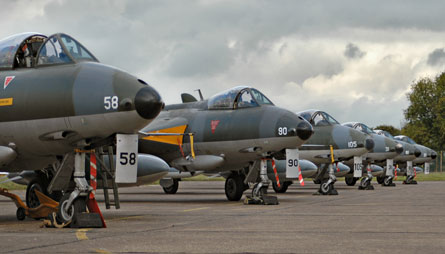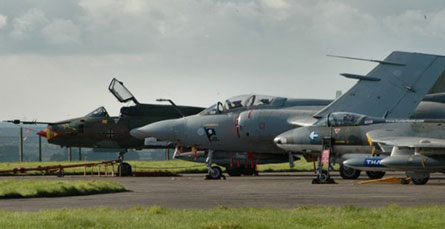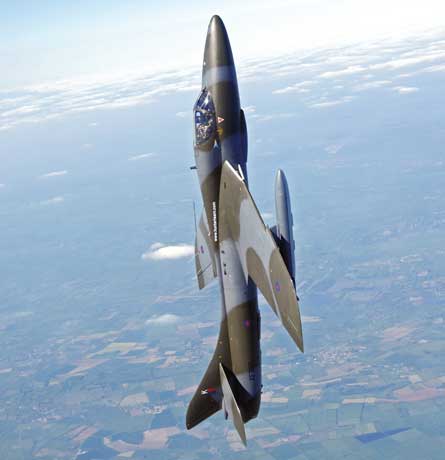Few British military aircraft of the jet age arouse such passion and endearment as the Hawker Hunter. Entering operational service with the UK Royal Air Force in 1954, it went on to win wide pilot acclaim for its excellent handling qualities and superb manoeuvrability. It was also an outstanding export success, being sold to the air arms of another 18 countries and enjoying a front-line career spanning almost 50 years.
Almost 2,000 Hunters rolled off the production line, of which several dozen are still flying in the hands of private operators worldwide. Many are displayed on the airshow circuit, where the Hunter's swept aesthetic makes it revered as perhaps the most graceful icon of Britain's post-war aviation industry.
But not everyone considers the type to be past its sell-by date as a working machine. UK-based Hawker Hunter Aviation (HHA) owns and operates 12 ex-Swiss air force Mk58 single-seaters plus two ex-RAF T8 trainers as part of its 16-strong fast jet fleet, and is convinced that this thoroughbred still has much to offer in the military support marketplace. Indeed, the company now has four aircraft back on the military register to service contracts with FR Aviation (FRA) and Qinetiq, and is chasing several more opportunities in the military flight trials and training market.
 |
|---|
© Hawker Hunter Aviation |
Hard-nosed approach
HHA managing director Mat Potulski takes an unashamedly hard-nosed approach. "This is about being a defence service provider, not a flying circus," he says. "The Hunter Mk58 allows military and defence industry customers to significantly cut the costs associated with fast-jet taskings. These operations are by definition expensive, and with pressure on budgets, and new equipment costs spiralling, there is increasing interest in the use of low-cost 'legacy' platforms for support and training.
"We are able to replicate the majority of the profiles once performed by air forces but now increasingly outsourced to the private sector. That ranges from all aspects of aerial combat training, trials support, high-speed photo chase and radar calibration."
Operating from RAF Scampton in Lincolnshire, HHA claims to be the Europe's largest commercial operator of "legacy" fast jet aircraft. As well as its Hunters, it also has an ex-German air force Sukhoi Su-22 in airworthy condition, while an ex-RAF Blackburn Buccaneer is close to being returned to flying status (both aircraft pictured below). Potulski believes the company is unique in its ability to offer contractor-operated high-speed aerial threat simulation and mission support training services, adding that it is "the only dedicated fast-jet operator holding both Civil Aviation Authority and UK Ministry of Defence design, maintenance and operating approvals".
 |
|---|
© Hawker Hunter Aviation |
The story of how HHA came into being starts in the mid-1990s. Potulski, who was enjoying a successful career as a management consultant in London's financial sector, and the late Mark Hanna, a former RAF pilot and one of the most accomplished display pilots of his generation, began to explore the business case for a "contractorised" fast jet squadron. Their thinking was that the enterprise would be tasked in a variety of support roles - such as research and trials flying, aggressor training, and target towing - so releasing front-line aircraft from second-line duties that consumed both funds and fatigue life.
"We had by then already begun to see contractor-operated business jets flying in support of military trials and training," Potulski says, "but these have obvious performance constraints. A fleet of ex-military fast jets appeared to us to be a natural next step, so we began to look at a number of types [including the Aero Vodochody L-39/59, BAE Systems Hawk, Dassault/Breguet Alpha Jet, Douglas A-4 Skyhawk and North American F-100 Super Sabre], evaluating them on grounds of both absolute performance and through-life costs.
Low-hours airframes
"As it happened, the Swiss government's decision to retire its Hunter fleet offered us the opportunity we'd been looking for. They were all low-hours airframes [the fleet leader still has over half its airframe life remaining] maintained in superb condition, so we [through the Old Flying Machine Co] purchased 12 single-seat Mk58s and obtained hangarage at Scampton.
"The Hunter was a perfect choice," he continues. "It offers viceless handling, superlative subsonic performance, excellent reliability and good internal and external payload."
 |
|---|
© Hawker Hunter Aviation/Qinetiq |
The seeds were sown. But everything was put on hold in late September 1999 when Hanna died following a vintage aircraft crash in Spain. Shortly afterwards their chief jet engineer also succumbed to cancer. Potulski, up until then very much the silent partner in the embryonic venture, was left to decide whether the nascent business had a future.
"I remember going up to Scampton in November 1999," he recalls, "to find a bunch of aircraft in a pretty sorry state. We had no infrastructure, no spares, no engineering, no security and no regulatory approvals."
Despite this unpromising situation, Potulski re-visited the original business proposition and concluded that it still had merit. "Looking at the way the military market was evolving, and taking a 10-year view on what it would cost to run the aircraft, I concluded that this was an opportunity still very much worth pursuing - but it would require significant investment."
HHA was registered in 2000. Since then, several million pounds have been invested to build up the operational and engineering infrastructure required of a "private" air force. Eight full-time air engineering staff, all senior ex-RAF non-commissioned officers, are now based at Scampton, and five former military pilots - all with over 3,000 fast jet flying hours - retained to fly according to demand. As for the aircraft themselves, Potulski assesses the general performance and capability of the Hunter Mk58 "to be in excess of many more modern types that would exhibit very marginal, if any, performance advantage in the subsonic sphere".
The airframe is stressed to +7.5g/-3.75g, and the various aircraft modifications incorporated in the Swiss build standard remain live, such as an integral radar warning receiver, chaff and flare dispensers and clearances for a wide range of underwing stores.
Upgrades
HHA has in the meantime introduced a new radar altimeter, upgraded communications and a GPS-aided navigation suite, and made the aircraft compatible with the RAIDS rangeless instrumented debriefing system pod. Next it plans to add an integral radar threat simulator.
Gaining AvP67 approval in July 2006 - a MoD sanction that endorses the company's maintenance and operating standards to military levels - was pivotal for HHA, as it allowed the company to begin operating aircraft on UK MoD taskings. This was quickly recognised by FRA, which is now using the Hunter as one of a number of targets to support the testing of the Sampson radar equipping the Royal Navy's new BAE-built Type 45 destroyers.
"We beat all other competition on the grounds of overall performance, cost effectiveness and flexibility," Potulski says. "Under a serviced contract arrangement, a number of Hunters are being tasked as agile fast jet targets, operating from Bournemouth [in Dorset] in conjunction with FRA's own [Dassault] Falcon aircraft. This is the first ever contract where taskings of this nature have been outsourced to a dedicated fast jet private contractor," he adds.
 |
|---|
© Hawker Hunter Aviation |
All aircraft modification and certification has been undertaken in-house by the company's engineering staff, including the integration of task-specific GPS data loggers supplied by FRA. As FRA's own pilots fly most of the missions, HHA has also undertaken their conversion and aircrew training.
Qinetiq is using one of HHA's T8 trainers for an altogether different purpose. "The Empire Test Pilots' School uses one of our two-seaters as required as part of its test pilot training syllabus," says Potulski. "In this case, ETPS instructors fly the aircraft to show students specific parts of the flight envelope that none of the other aircraft in their fleet can replicate." Flown from Boscombe Down, Wiltshire, the aircraft is used to demonstrate handling characteristics on an unfamiliar type.
To date, HHA's Hunter fleet has completed over 500 incident-free sorties and achieved 99% serviceability. "In the course of all flight operations, not a single sortie has been lost due to technical unserviceability," says Potulski. "That is testament to the quality of our engineers, and also a reflection of the simplicity and reliability of the aircraft."
HHA's Hunter fleet has at least another 10 years on the clock, possibly much more. Potulski's strategy for the next three years is to build on early success by securing further long-term contracts that would help amortise overheads and aid business planning in the longer term. "There are several opportunities emerging in both the UK and wider NATO market that we are pursuing," he says, "addressing both the trials support front and also the provision of fast jet pilot assessment, training, conversion and currency flying."
Scaleability
HHA's contracting model stands or falls on the company's ability to minimise overheads while ensuring strict adherence to the stringent regulatory and safety requirements of the CAA and MoD. "Maintaining the appropriate currencies and standards clearly costs money in terms of training, equipment, spares, labour, consumables and so on," Potulski points out. "But the key word I tend to use is 'scaleability'. In other words if we need more or less aircraft on line then we have the contacts, assets, spares and so on to be able to react rapidly.
"When airframes come off tasking we want to be able to stand them down knowing that their reactivation to flight status could be readily achieved without undue effort. And we will never be short of pilots who want to fly the Hunter."
Nor does HHA rule out acquiring other platforms where there is a specific requirement, says Potulski. "Our expertise really lies in sourcing the appropriate legacy platforms for the job, upgrading these on a bespoke basis with modern systems and operating them effectively. If a tasking were to fall outside the performance envelope of our existing aircraft, we would evaluate different types to fulfill the need."
Source: Flight International
















